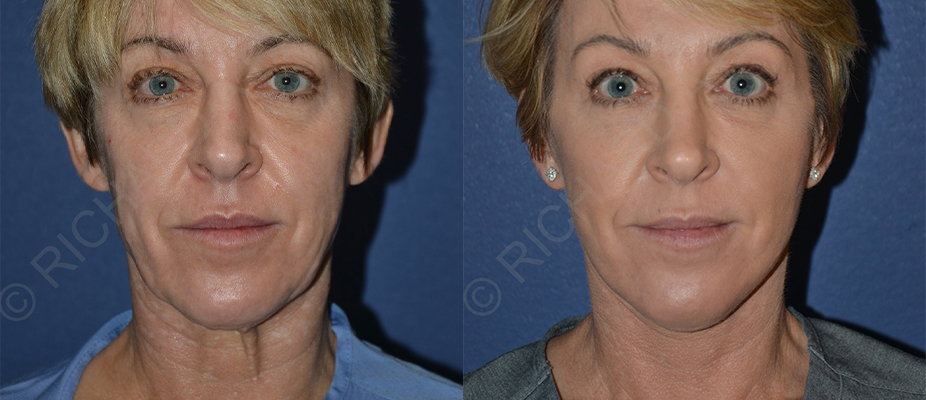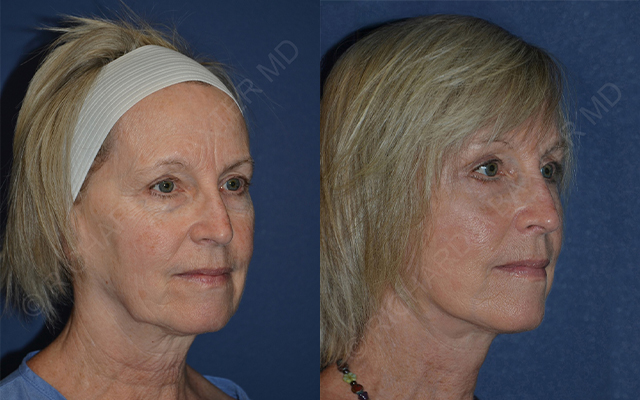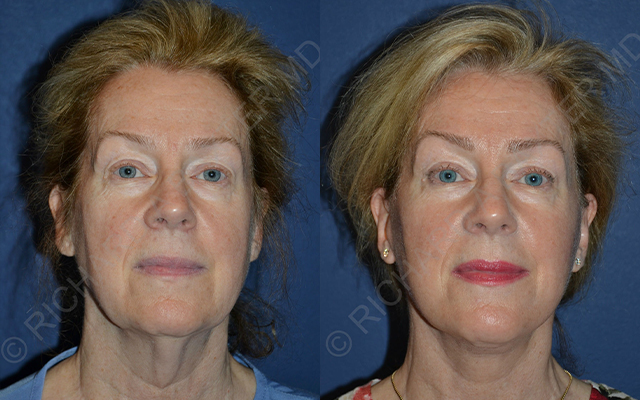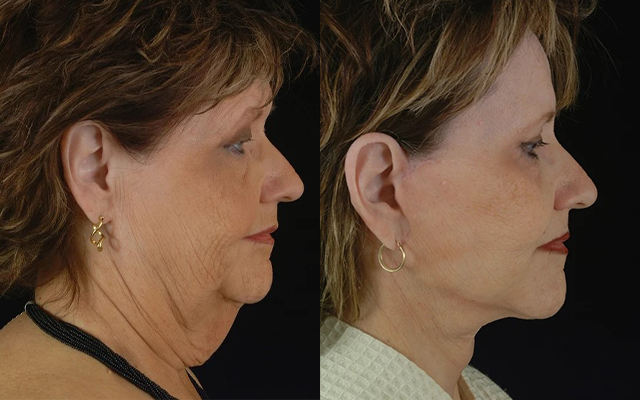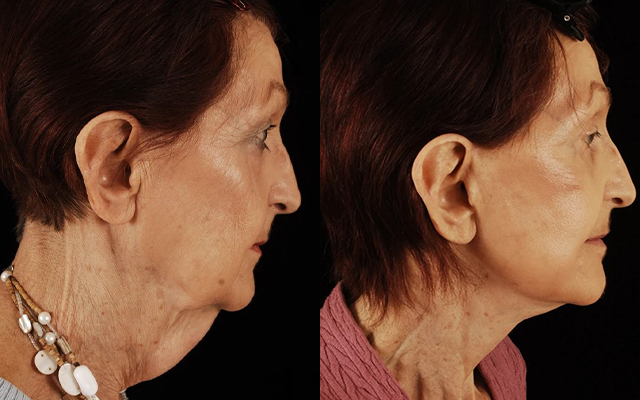Facelift & Neck Lift in Seattle, WA | PHASE Plastic Surgery
The face and neck are often the first areas to show signs of aging. This is the result of skin exposure to the elements in addition to laxity in the deeper facial tissues and volume loss. To help restore a more youthful appearance, facelift surgery works by repositioning the skin and deep facial tissues together, using the Deep Plane/SMAS method. At the same time, a neck lift reshapes and tightens the skin and underlying platysma muscle in the neck to create a tighter look for a leaner, more youthful neckline.
For many years, stereotypes have surrounded facelift surgery. As a result, many people have been afraid to pursue a facelift for fear of getting the “pulled” look. Fortunately, at PHASE Plastic Surgery near Seattle, WA, board-certified plastic surgeon Dr. Richard A. Baxter utilizes advanced techniques such as the Deep Plane/SMAS, regenerative fat grafting, and hemostatic net that aid in a faster recovery and more natural-appearing facelift results.
The key to creating natural-looking results is recognizing that aging occurs at several anatomic layers, which is where the deep plane/SMAS method comes in. Additionally, our surgeons will customize the operation to meet each patient’s specific needs, using advanced surgical techniques, such as regenerative fat grafting. Contact us today to schedule your facelift and neck lift consultation. Our office is located just north of Seattle, outside the hustle of the city, for easy, convenient access
What is a Facelift?
A rhytidectomy, commonly referred to as a facelift, is a facial plastic surgery procedure used to reposition muscle, skin, and tissue to address common signs of aging, such as:
- Deep facial creases
- Jowls
- Loose facial skin
- The “sunken” appearance where subcutaneous fat has been lost
- Loose skin and separation of the platysma muscle ("Turkey Neck")
- A double chin
- Sagging cheeks
During a facelift consultation, we will ensure you’re a healthy candidate for surgery and discuss other standard options that may complement your facial rejuvenation journey. For example, many patients choose facial fat grafting to help restore volume loss, especially around their cheeks and underneath their eyes. Eyelid surgery is also commonly paired with a facelift.
What Is a Deep Plane Facelift?
A Deep Plane/SMAS facelift is a facial plastic surgery procedure used to reposition skin and deeper tissue layers for 3-dimensional shaping to address common signs of aging, such as:
- Deep facial creases
- Jowls
- Loose facial skin
- The “sunken” appearance where subcutaneous fat has been lost
- Loose skin and separation of the platysma muscle (“Turkey Neck”)
- A double chin
- Sagging cheeks
During a facelift consultation, we will ensure you’re a healthy candidate for surgery and discuss other options that may complement your facial rejuvenation journey. For example, many patients choose facial fat grafting to help restore volume loss, especially in their cheeks and underneath their eyes. Eyelid surgery is also commonly paired with a facelift.
What Is a Neck Lift?
A neck lift, medically referred to as a lower rhytidectomy or submental lipectomy, is another facial rejuvenation procedure designed to improve signs of aging from the jawline down to the clavicle. Due to it being a highly versatile procedure, it can be approached in various ways. For example, our surgeons may use a combination of these techniques during your neck lift:
- The removal of excess loose skin
- A technique called Platysmaplasty tightens neck muscles
- Removal of pockets of fat
- The redistribution of fat through fat injections
Similar to a facelift, during a neck lift consultation, your eligibility for surgery will be carefully determined after a thorough review of your medical history and expectations. Once we know that you’re a good candidate, we’ll begin the collaborative process of designing your unique combination of surgical and non-surgical techniques that work best for your situation.
Why Should I Choose PHASE Plastic Surgery for My Face and Neck Lift Surgery?
When you choose PHASE Plastic Surgery, you will receive state-of-the-art care in terms of techniques and technology used and how each of our doctors and staff relates to your struggles, insecurities, and goals. Our approach is personalized and collaborative to help you feel the most at ease, comfortable, and confident, as each decision made is entirely made by you.
As an art major with a science aptitude, Dr. Baxter took his background in art and applied it to his surgical approaches allowing him to use creative problem-solving skills and an artistic lens to the masterpieces he creates through surgery. One of the most significant rewards he finds in his profession is seeing the joy on his patient’s faces when they experience their results for the first time.
Our skilled plastic surgeon, Dr. Baxter, is board-certified. His goal with all surgery is to achieve a natural result and avoid the excessively over-operated look.
At PHASE Plastic Surgery, we strive to make the decision process fun, educational, and exciting for our patients. As a pioneer in many advanced surgical techniques, Dr. Richard Baxter’s unique surgical methods and artistic background create stunning and natural results that enhance your lifestyle.
What Are the Benefits of Facelift and Neck lift Surgery in Seattle, WA?
Restore facial contours
Face and neck lift surgery is primarily considered a restorative surgery because it both tightens and smooths the skin that frames your face. Sagging tissue around the jawline, neck, and cheekbones can hide the curves and definition of your face making you appear older or even heavier than you are. During a face and neck lift procedure, we can lift the cheeks to improve the definition of your cheekbones, while a neck lift will remove excess skin and fat along your jawline, creating a more defined and youthful neckline. Enhancing your face and neck can help you look younger, thinner, and healthier.
Natural, Long-Lasting Results
A common misconception that some people have when it comes to facial plastic surgery, especially facelifts, is that their results will look fake and unnatural. Our plastic surgeons take extensive care and precautions to ensure this is not the case. Our advanced methods, thorough knowledge of facial anatomy, and state-of-the-art techniques equip him to create results that look and feel natural. Our mission is to enhance the features you have rather than change them.
Target Various Signs of Aging in One Step
A face and neck lift operation allows you to treat multiple signs of aging in one surgery rather than choosing which issue you’d like to target more. For example, a face and neck lift will address sagging skin, deep wrinkles, creases between the nose and mouth, double chin, and issues with excess fat, all in one surgical procedure.
What To Expect from Facelift and Neck Lift Surgery in Seattle

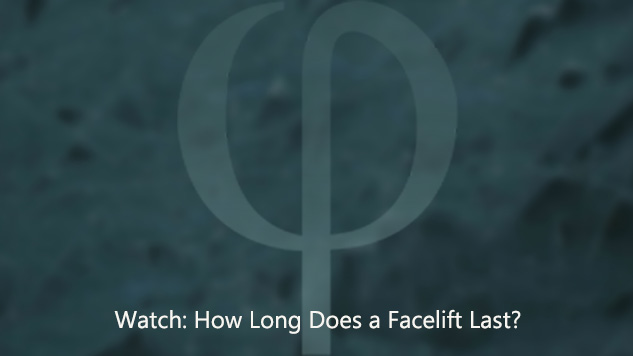
Preparation for a smooth and comfortable experience begins in the days leading up to surgery through a program we call ERAS (Enhanced Recovery After Surgery), which has been proven to reduce stress, minimize postoperative discomfort, and ease emergence from anesthesia. Before entering your surgical suite, you’ll first meet with your surgeon, an anesthesiologist, and our excellent nursing staff to gain comfort and familiarity with the entire team. At this time, you are free to ask any last-minute questions, discuss any concerns, and learn more about your surgical team.
Your surgery will begin by receiving general anesthesia or IV sedation. For a facelift, incisions are made around the hairline and ears or just around the ears. If only a neck lift is being done alone, incisions are typically made around the earlobe, along the hairline, and down the neck. After the incisions have been made, liposuction, skin removal, fat transfer, or other techniques will be utilized, depending on your treatment plan. Then, the incisions are closed using skin glue or sutures. When the incisions fully heal, they are generally camouflaged by the hairline and hidden from view.
Once it’s deemed safe for you to be released, you’ll be sent home with prescription medication to help minimize your risk of infection and manage any discomfort. Although the recovery time differs for every patient, it generally takes about three weeks to recover from a facelift or neck lift.
Natural Beauty For Every Phase in Life

Schedule Your Seattle Facelift and Neck Lift Consultation at PHASE Plastic Surgery
Our facial appearance is our first and direct communication with the people and world around us. A youthful facial and neck appearance absent of loose skin, deep creases, and jowls can have long-lasting, incredible effects on your self-confidence, resulting in better relationships and interactions with our community and professional opportunities.
Age with grace and reclaim control of how you age with a customized facelift or neck lift. To get started, contact PHASE Plastic Surgery to learn more about your surgical options. Our reputation is largely based on experiences and reviews from past patients, so be sure to explore our patient review section and learn more about our Seattle office.
Call PHASE Plastic Surgery at (425) 776-0880 or reach out to us by sending a message through our website. Our practice is conveniently located in a suburb just North of Seattle for convenient accessibility.
Facelift & Neck Lift FAQs
This depends on how private you wish to be. If you don’t want anyone to know you had surgery, plan for around 3 weeks or so. The first week is downtime at home, then another week of social downtime, and the third week is transitional. Certain “diversionary tactics” can direct attention away from the obvious changes. For more pointers, go to How To Keep Your Plastic Surgery Discreet.
A facelift reverses many visible signs of aging but doesn’t slow the aging process. For that reason, good skin care and anti-aging strategies are essential to maintain the results. This can include advanced skin care products such as OneSkin and Emepelle, Ultherapy microfocused ultrasound, and microneedling with exosomes. Sun protection and good nutrition play a role as well. See also: How To Maintain The Results Of A Facelift.
A full facelift addresses signs of aging in the neck, jawline, and cheeks. A mini facelift is not a standardized term but typically involves a shorter scar and focuses mostly on the cheeks or jawline. A neck lift could also be considered a mini-facelift. Often, however, a full facelift yields a more natural look.
It is generally best to think about what you would like to see improved before deciding on a specific procedure. There are some things a facelift does very well, such as reshaping the cheeks and smoothing the jawline, but other areas, such as fine lines around the mouth or eyes, may do better with a different procedure. Trust your plastic surgeon to make the best recommendation for you.
You will be given specific guidance on preparing for the best outcome at your pre-operative visit and consultation. Things to know include:
- Avoiding medications that may interfere with blood clotting, such as NSAIDs, aspirin, and certain herbal products;
- Arranging your caregiver to be with you for at least the first 24 hours;
- Stocking up on healthy foods that don’t require a lot of chewing.
Simple things like button-up pajamas and clothing will make life easier as well.
Every surgery has risks, but a facelift is a safe procedure for a healthy person. Complications include: bleeding resulting in a hematoma, unfavorable scarring, wound infection, and facial nerve damage (usually resolves with time.)
We do not recommend having a facelift if you use any nicotine-containing products. Nicotine causes constriction of blood vessels and can severely impair the healing process, possibly resulting in tissue loss. We do not believe that it is an acceptable risk.
While it can vary, plan a week of “downtime” at home, then at least another week or two of social downtime. You can resume many of your usual activities during the second week if you don’t over-exert. It can be a few weeks before the bruises have completely faded and the swelling has resolved.
We typically recommend at least 3 weeks before heavy exertion. You should begin walking and light activity within the first week.
Returning to work depends on how much you need to keep your surgery private and, of course, the physical exertion required. Modern surgical techniques generally result in a faster recovery, but returning too soon can cause a setback. We will offer advice about your return to work when we see you in consultation.
Facelift patients can be as young as mid 30’s and up to mid-80s. Younger facelift patients typically do it for sagging skin after weight loss or fullness in the neck, resulting in skin laxity after fat reduction. The most common age in our practice is mid-50s to mid-60s.
A facelift is a 3-dimensional operation that restores shape and natural fullness in the cheeks, smoothes lax skin, and should result in a long-lasting restoration of appearance. No non-surgical procedures do all of this, and even when combined, the result is less effective. However, younger patients often find non-surgical treatments a good way to maintain their youthfulness and postpone the need for a facelift.
The liquid facelift is a gimmicky term to describe the use of injectable fillers. Volume restoration is important because fat loss in the face is a hallmark of aging, but only one component. We love our fillers, but it isn’t a facelift.
Think of a facelift as ‘setting back the clock” rather than having a temporary effect. A well-performed facelift will take 10-15 years off for most patients.
Facelifts are customized to each individual, using various techniques, including fat grafting, SMAS lifting, correction of platysma bands in the neck, and skin redraping. Our emphasis here is natural-appearing, balanced, and healthy, not pulled and overdone.
A key to the natural reshaping of the face is to make a deeper layer called the SMAS do the lifting rather than pulling more on the skin. A deep plane facelift is a variation of the SMAS facelift, and there is debate about whether it is actually something different. The term has been in use for more than 30 years but it has evolved. Realistically, every deep plane facelift is a SMAS facelift. For that reason, it is difficult to prove that the results are better, longer-lasting, or even different.
The SMAS (Superficial MusculoAponeurotic System) is a layer of connective tissue and facial muscles under the skin. Most facelifts are done with the Deep Plane/SMAS layer to lift and reshape in 3 dimensions so the skin doesn’t look pulled. The results appear more natural because the skin is elevated with the SMAS. The deep plane facelift is a variation of the SMAS technique.
Because a facelift is a meticulously done procedure, it can take several hours. Less than that, and shortcuts have to be taken, but it should take more than 3-5 hours either.


